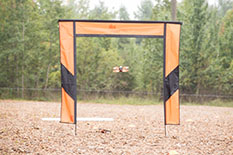UMD Opens Outdoor Flight Laboratory to Advance Autonomy, Robotics
Today the University of Maryland (UMD) A. James Clark School of Engineering opens the only university outdoor flight laboratory for testing unmanned aircraft systems (UAS) in the D.C.-Maryland-Virginia region. Located minutes from the main College Park campus in the UMD Discovery District, the netted Fearless Flight Facility (F3) will serve as a catalyst for innovation in the areas of flight control, sensing, autonomy, collaboration, and counter-UAS. “The University of Maryland continues to make incredible strides in autonomy and robotics. Facilities like this one provide the real-world testing conditions that enable innovative breakthroughs,” said Clark School Dean and Farvardin Professor of Aerospace Engineering Darryll Pines. “F3 allows us to pursue an aggressive UAS research agenda that would not be possible without the protection of a netted enclosure.” Student and faculty researchers who were confined to testing vehicles in a lab or not at all will now have room to iterate on the fly. The 100-foot wide, 300-foot long, and 50-foot high facility also serves as a critical nexus between the Clark School of Engineering’s College Park labs and the UAS Test Site in Maryland’s St. Mary’s County. “With F3, we can conduct cohesive, comprehensive research and education programs in concept and development, testing and evaluation, and life-cycle testing,” said Norman M. Wereley, Department of Aerospace Engineering professor and chair. The airspace over the greater D.C. area is the most restricted in the country, with all UAS flights within a 15-mile radius of Ronald Reagan Washington National Airport prohibited without authorization from the federal government. Because F3 is considered indoors, these and other restrictions on outdoor flights do not apply. At the same time, the open black polyester netting allows researchers to experiment in real world wind and weather conditions. Advances to equipment and algorithms made possible by the facility have a host of applications. New vehicle configurations can improve the efficacy of UAS in search-and-rescue operations, for example, while progress in the field of cooperation could lead to surveys of large swaths of farmland quickly and at low cost. To view F3 flight photos, visit go.umd.edu/fearlessflightphotos.
Related Articles: September 13, 2017 Prev Next |


